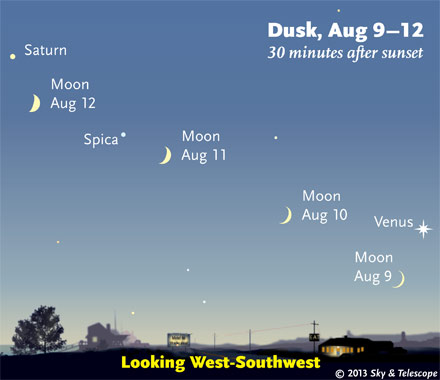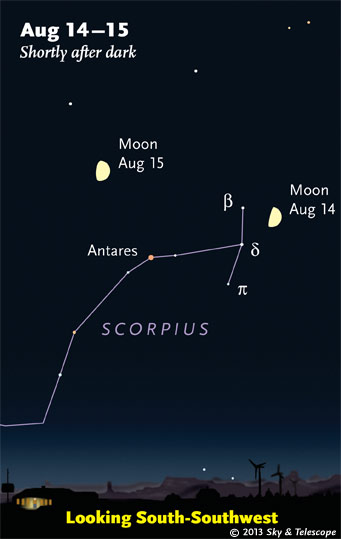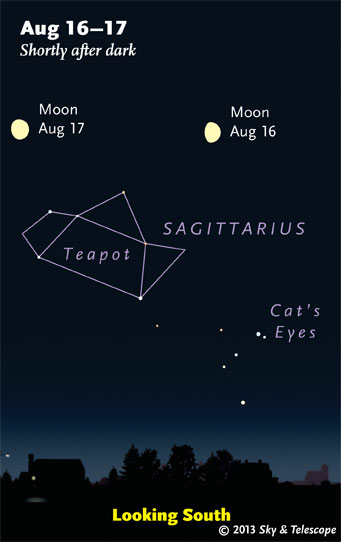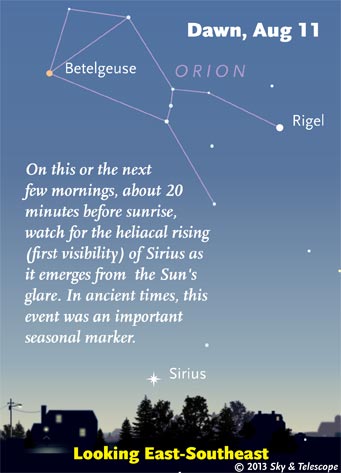Supernova in M74. The supernova in the spiral galaxy M74 was still magnitude 12.5 as of August 8th, and turning from white to pale yellow. It's in Pisces, well up in the east by 2 a.m. See our article Supernova Erupts in M74, and see its up-to-date light curve.

Back in the evening sky, the waxing crescent Moon passes Venus and Saturn.
Friday, August 9
Saturday, August 10
Sunday, August 11
Monday, August 12
Tuesday, August 13

The Moon waxes across upper Scorpius...

...and then shines above the Teapot of Sagittarius.
Wednesday, August 14
Thursday, August 15
Friday, August 16
Saturday, August 17
Want to become a better amateur astronomer? Learn your way around the constellations. They're the key to locating everything fainter and deeper to hunt with binoculars or a telescope.
This is an outdoor nature hobby. For an easy-to-use constellation guide covering the whole evening sky, use the big monthly map in the center of each issue of Sky & Telescope, the essential guide to astronomy. Or download our free Getting Started in Astronomy booklet (which only has bimonthly maps).
Once you get a telescope, to put it to good use you'll need a detailed, large-scale sky atlas (set of charts). The standards are the little Pocket Sky Atlas, which shows stars to magnitude 7.6; the larger and deeper Sky Atlas 2000.0 (stars to magnitude 8.5); and the even larger Uranometria 2000.0 (stars to magnitude 9.75). And read how to use sky charts with a telescope.
You'll also want a good deep-sky guidebook, such as Sue French's Deep-Sky Wonders collection (which includes its own charts), Sky Atlas 2000.0 Companion by Strong and Sinnott, the bigger Night Sky Observer's Guide by Kepple and Sanner, or the beloved if dated Burnham's Celestial Handbook.
Can a computerized telescope replace charts? Not for beginners, I don't think, and not on mounts and tripods that are less than top-quality mechanically (able to point with better than 0.2° repeatability, which means heavy and expensive). As Terence Dickinson and Alan Dyer say in their invaluable Backyard Astronomer's Guide, "A full appreciation of the universe cannot come without developing the skills to find things in the sky and understanding how the sky works. This knowledge comes only by spending time under the stars with star maps in hand."
This Week's Planet Roundup
Mercury, Mars, and Jupiter shine in the east-northeast before and/or during dawn. Jupiter is the highest and brightest (magnitude –1.9). Look for faint Mars (magnitude +1.6) increasingly far to Jupiter's lower left. Both are in Gemini, with Pollux and Castor to Mars's left.
Look far down to Mars's lower left, as dawn brightens, for Mercury (magnitude —1). It's sinking lower every day. Don't confuse Mercury with Procyon, far down to Mars's lower right.
Venus (magnitude –3.9) shines brightly very low in the west in evening twilight. In a telescope Venus is still small (13 arcseconds) and gibbous (80% sunlit).
Saturn (magnitude +0.7, between Virgo and Libra) glows in the southwest as twilight fades, with Spica 12° to its lower right. High to their upper right is brighter Arcturus.
Uranus (magnitude 5.8, in Pisces) and Neptune (magnitude 7.8, in Aquarius) are both in view in the southeast by midnight. Finder charts for Uranus and Neptune.
All descriptions that relate to your horizon — including the words up, down, right, and left — are written for the world's mid-northern latitudes. Descriptions that also depend on longitude (mainly Moon positions) are for North America. Eastern Daylight Time (EDT) equals Universal Time (also known as UT, UTC, or GMT) minus 4 hours.
Like This Week's Sky at a Glance? Watch our SkyWeek TV short, also playing on PBS.
To be sure to get the current Sky at a Glance, bookmark this URL:
http://SkyandTelescope.com/observing/ataglance?1=1
If pictures fail to load, refresh the page. If they still fail to load, change the 1 at the end of the URL to any other character and try again.
 0
0

Comments
You must be logged in to post a comment.